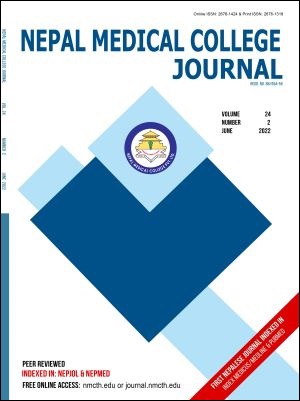Prevalence of malnutrition among under-five children residing in Kamal Gaupalika, Jhapa
DOI:
https://doi.org/10.3126/nmcj.v24i2.46025Keywords:
Contributing factors, malnutrition, prevalence, under-five childrenAbstract
Malnutrition among under-five is a major global health problem in developing countries like Nepal. It directly or indirectly affects many aspects of the child’s health, adversely affecting growth and development. Also, malnutrition affects the child’s ability to learn and process information and growth. This study assesses the prevalence of malnutrition among under-five children in Kamal Gaupalika, Jhapa, Nepal. First, a descriptive cross-sectional method was conducted among 60 under-five children and their mothers. The interview included semi-structured and structured questionnaires regarding socio-demographic and contributing factors of malnutrition and anthropometric measurement (analog weighing machine, measuring tape, mid-upper arm circumference) used for data collection. Then, the collected data were analyzed using SPSS-16, employing descriptive statistics (i.e. percentage, frequency, mean and standard deviation) and inferential statistics (i.e. chi-square). This study shows that 41.67% were malnourished. Among them, stunting was 20.0%, wasting was 25.0%, and underweight was 31.7%. Anthropometric measurement showed 83.3% were well-nourished, 11.7% were at risk for acute malnutrition, and 5% were moderate acute malnutrition. Family income was found to be significantly associated with malnutrition (stunting p = 0.001, wasting p = 0.007 and underweight p = 0.000). In contrast, there was no association in age, gender, ethnicity, mother’s education, father’s education, and mother’s age at childbirth. Our results showed that malnutrition is prevalent in the selected study area. Therefore, community-based nutrition awareness and education programs are necessary to improve the nutritional status of children.
Downloads
Downloads
Published
How to Cite
Issue
Section
License
Copyright (c) 2022 Nepal Medical College Journal

This work is licensed under a Creative Commons Attribution 4.0 International License.
This license enables reusers to distribute, remix, adapt, and build upon the material in any medium or format, so long as attribution is given to the creator. The license allows for commercial use.




